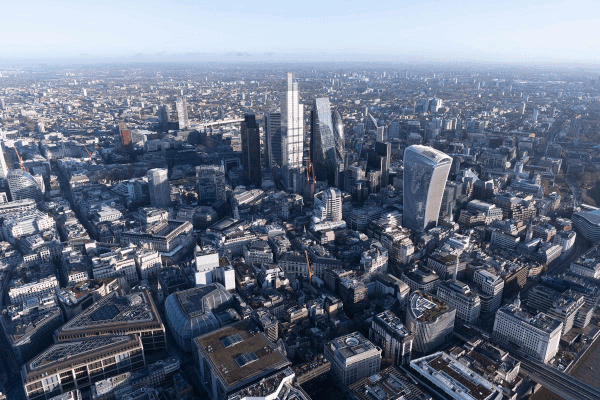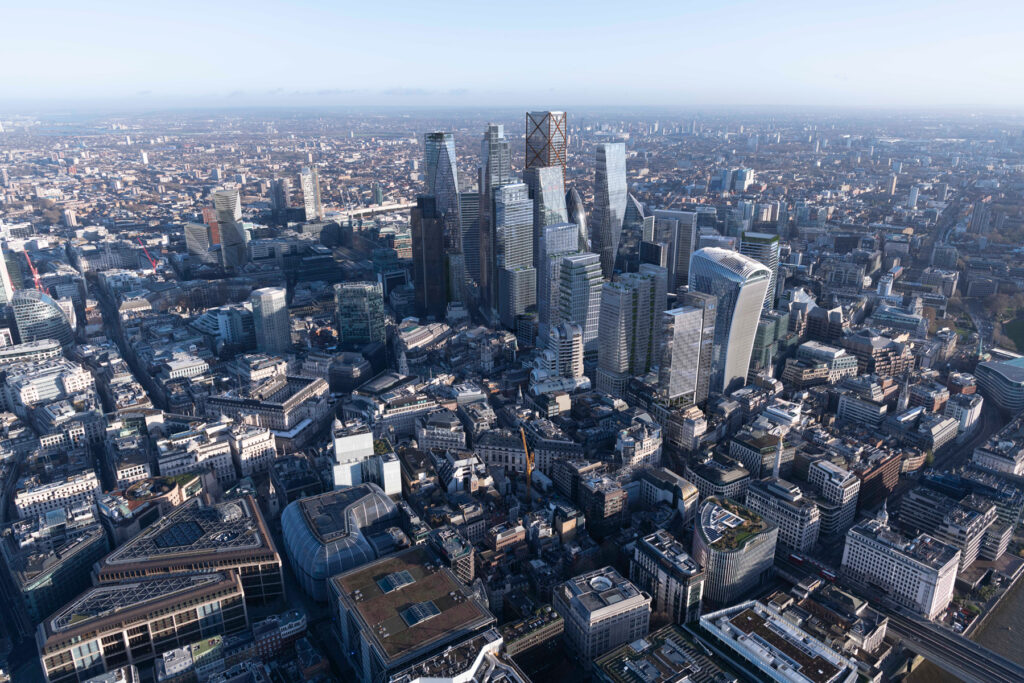The ever changing skyline of the City of London will look very different by the end of the decade, as the City has released a vision of what the Square Mile will look like in 2030.
The new images capture all major developments which have been approved or resolved to be approved by the City Corporation over the past 12 months and has been released amid a strong year of activity for the Planning and Transportation Committee, including a 25% increase in the applications received and decided, compared with the same period last year.
With city worker numbers rising by 29,000 since 2021 and now standing at 617,000 in total, the City of London is considering development proposals that would provide over 500,000 sqm of office space, equivalent to roughly 70 football pitches, with a further 500,000 already approved and under construction.
Demand for sustainable office space remains high, as estimates based on GLA data show that city job numbers should grow by a further 85,000, up to 2040. This is backed by a report from Arup and Knight Frank, showing a need of approximately 1.2m sqm of extra office space in the city by 2040, to accommodate this job growth.
Chair of the Planning and Transportation Committee at the City of London Corporation, Shravan Joshi, said: “These new CGI images clearly illustrate the ever-changing nature of London’s incredible skyline. It demonstrates that the City office is here to stay, and that the Square Mile’s real estate sector is robust and thriving, despite wider economic concerns.
“Through our flagship ‘Destination City’ policy, we are creating a culturally vibrant, inclusive and welcoming City, enabled in part by these tall towers which help accommodate the hospitality, leisure, social and cultural destinations that are flocking to the City.
“The City Corporation’s strong performance this year is underpinned by the Built Environment team’s efforts to de-risk many of the variables associated with real estate investment. This includes providing clear policy directives, working closely with stakeholders and undertaking transparent consultation on schemes.”









At least they help to hide the Walkie-Talkie
My first thought too! 🙂
What boring mess of dated architecture, the once great City of London is becoming. A very cheap version of Dubai.
London’s a lot more expensive. The price per square metre is about four times higher in central London than Dubai. Perhaps you find Dubai’s architecture more impressive, but I can’t say I do.
I thought 1 Undershaft got a re-design from the ‘trellis’ version? Is it shown because that version has been approved, and the proposed replacement design hasn’t?
Yes, pretty much.
Perhaps the Square Mile could be extended a little so that the skyscrapers could be less concentrated?
It’s not like the old Corporation is short of cash, is it? And they already own land (ok, cemetaries) in the rest of Greater London.
The extent of the Eastern Cluster in the City of London is a product of the protected views cutting across London, particularly those focused on St Pauls Cathedral. These also drive the shape of some of the towers.
The Square MIle was extended in the early 1990s when the boundaries were shifted to e.g. make Broadgate part of the City. And Shoreditch, whilst in Tower Hamlets, is the outlet for the eastern grwoth, with Islington to the north.
Maybe they’ll finish off the old Westminster Bank building (or whatever it’s called these days). The black core poking out of the chrome and glass tower looks as though they couldn’t be bothered to finish it off.
No, it’s actually one of the best towers in London. The massing is very subtle and very clever, with the tops and bottoms of each of the three ‘leaves’ stopping at different heights. The detailing and the materials are superb, and having been up it, looked down on it and watched it in the sun from my office window, it’s better than anything else there. For more see my piece at https://www.chrismrogers.net/citytower42
How long it will take for people to understand that the future of Britain belongs to suburbs, not the overcrowded city centers? How many leasehold crook companies must go bust to reinforce that message?
Maybe I’m being a little bit too cynical, but my first thought on seeing the “before and after” image was that the City Fathers have given in to good ol’ keep up with the Joneses competitiveness and decided to scrape the sky as brashly as their naughty child downriver in Docklands.
Contrary to the other commenter above, I’d argue that grouping all the damn things in one quarter is best. As a big splodge they somewhat disappear, whereas popping up singly across the square mile they’d loom larger in our eye line.
Looks beautiful!
Grouping these monstrosities all together doesn’t mitigate the fact that London now looks pretty much like any other major city on the planet (except Paris, which has very wisely excluded tower blocks from its city centre). Which is a shame, seeing that our unique architectural history dates back at least to Roman times.
We need to fight to preserve what is left, or in future we will have nothing of our heritage. And these new high-rise buildings will be pulled down in 50 years or less, as obsolete.
It’s a pretty depressing picture, not helped by the disingenuity of the City fathers’ commentary.
Anything to keep up with or outdo Canary Wharf
I can’t help wondering… Is it wise to build all these towers together on alluvial sand, mud and clay? Or has engineering got round that issue?
I believe some recent constructions have foundations down to the bedrock…
The London Clay layer is far deeper than any foundation could penetrate.
Taller you bastards!.. taller!